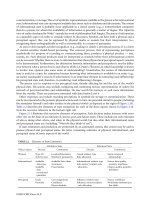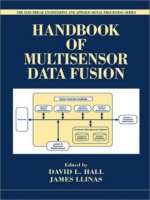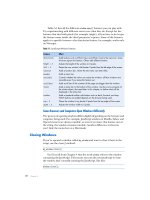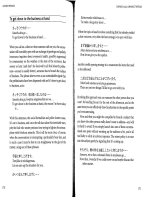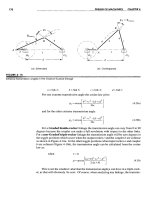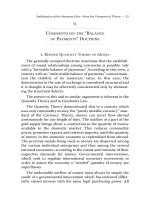handbook of multisensor data fusion phần 3 pot
Bạn đang xem bản rút gọn của tài liệu. Xem và tải ngay bản đầy đủ của tài liệu tại đây (114.72 KB, 4 trang )
©2001 CRC Press LLC
Within this metaphor, sensor data relates to the short-term knowledge, while long-term knowledge
relates to relatively static factual and procedural knowledge. Because the goal of both biological and
artificial situation awareness systems is the development and maintenance of the
current relevant percep-
tion
of the environment, the dynamic
situation description
represents medium-term memory. In both
biological and tactical data fusion systems,
current
emphasizes the character of the dynamically changing
scene under observation, as well as the potentially time-evolving analysis process that could involve
interactions among a network of distributed fusion processes. Memory limitations and the critical role
medium-term memory plays in both biological and artificial situation awareness systems enables only
relevant
states to be maintained. Because sensor measurements are inherently information-limited, real-
world events are often nondeterministic, and uncertainties often exist in the reasoning process, a disparity
between
perception
and
reality
must be expected.
As illustrated in Figure 6.7, sensor observables represent short-term declarative knowledge and the
situation description represents medium-term declarative knowledge. Templates, filters, and the like are
static declarative knowledge; domain knowledge includes both static (long-term) and dynamic (medium-
and short-term) declarative context knowledge; and F represents the fusion process reasoning (long-term
procedural) knowledge. Thus, as in biological situation awareness development, machine-based
approaches require the interaction among short-, medium-, and long-term declarative knowledge, as
well as long-term procedural knowledge. Medium-term knowledge tends to be highly perishable, while
long-term declarative and procedural knowledge is both learned and forgotten much more slowly. With
the exception of the difference in the time constants, learning of long-term knowledge and update of the
situation description are fully analogous operations.
In general, short-, medium-, and long-term knowledge can be either
context-sensitive
or
context-
insensitive
. In this chapter, context is treated as a conditional dependency among objects, attributes, or
functions (e.g., f(x
1
,x
2
|x
3
= a)). Thus, context represents both explicit and implicit dependencies or
conditioning that exist as a result of the state of the current situation representation or constraints
imposed by the domain and/or the environment.
Short-term knowledge is dynamic, perishable, and highly context sensitive. Medium-term knowledge
is less perishable and is learned and forgotten at a slower rate than short-term knowledge. Medium-term
knowledge maintains the context-sensitive situation description at all levels of abstraction. The inherent
context-sensitivity of short- and medium-term knowledge indicates that effective interpretation can be
achieved only through consideration of the broadest possible context.
Long-term knowledge is relatively nonperishable information that may or may not be context-
sensitive.
Context-insensitive
long-term knowledge is either generic knowledge, such as terrain/elevation,
soil type, vegetation, waterways, cultural features, system performance characteristics, and coefficients
of fixed-parameter signal filters, or context-free knowledge that simply ignores any domain sensitivity.
Context-sensitive
long-term knowledge is specialized knowledge, such as enemy Tables of Equipment,
FIGURE 6.7
Biologically motivated metaphor for the data fusion process.
Sensor input
Short-term declarative
Fusion Process, F
Long-term procedural
Database
Long-term declarative
Situation Description
Medium-term declarative
Update
Learning
©2001 CRC Press LLC
7
Contrasting Approaches
to Combine Evidence
7.1 Introduction
7.2 Alternative Approaches to Combine Evidence
The Probability Theory Approach • The Possibility Theory
Approach • The Belief Theory Approach • Methods of
Combining Evidence
7.3 An Example Data Fusion System.
System Context • Collections of Spaces • The System in
Operation • Summary
7.4 Contrasts and Conclusion
Appendix 7.A The Axiomatic Definition of Probability
References
7.1 Introduction
A broad consensus holds that a probabilistic approach to evidence accumulation is appropriate because
it enjoys a powerful theoretical foundation and proven guiding principles. Nevertheless, many would
argue that probability theory is not suitable for practical implementation on complex real-world prob-
lems. Further debate arises when considering people’s subjective opinions regarding events of interest.
Such debate has resulted in the development of several alternative approaches to combining evidence.
1-3
Two of these alternatives, possibility theory (or fuzzy logic)
4-6
and belief theory (or Dempster-Shafer
theory),
7-10
have each achieved a level of maturity and a measure of success to warrant their comparison
with the historically older probability theory.
This chapter first provides some background on each of the three approaches to combining evidence
in order to establish notation and to collect summary results about the approaches. Then an example
system that accumulates evidence about the identity of an aircraft target is introduced. The three methods
of combining evidence are applied to the example system, and the results are contrasted. At this point,
possibility theory is dropped from further consideration in the rest of the chapter because it does not
seem well suited to the sequential combination of information that the example system requires. Finally,
an example data fusion system is constructed that determines the presence and location of mobile missile
batteries. The evidence is derived from multiple sensors and is introduced into the system in temporal
sequence, and a software component approach is adopted for its implementation. Probability and belief
theories are contrasted within the context of the example system.
One key idea that emerges for simplifying the solution of complex, real-world problems involves
collections of spaces. This is in contradistinction to collections of events in a common space. Although
Joseph W. Carl
Harris Corporation
II
Advanced
Tracking and
Association
Methods
8 Target Tracking Using Probabilistic Data Association-Based Techniques with
Applications to Sonar, Radar, and EO Sensors
T. Kirubarajan and
Yaakov Bar-Shalom
Introduction • Probabilistic Data Association • Low Observable TMA Using the ML-PDA
Approach with Features • The IMMPDAF for Tracking Maneuvering Targets • A Flexible-
Window ML-PDA Estimator for Tracking Low Observable (LO) Targets • Summary
9 An Introduction to the Combinatorics of Optimal and Approximate Data
Association
Jeffrey K. Uhlmann
Introduction • Background • Most Probable Assignments • Optimal Approach •
Computational Considerations • Efficient Computation of the JAM • Crude Permanent
Approximations • Approximations Based on Permanent Inequalities • Comparisons of
Different Approaches • Large-Scale Data Associations • Generalizations • Conclusions •
Acknowledgments • Appendix 9.A Algorithm for Data Association Experiment
10 A Bayesian Approach to Multiple-Target Tracking
Lawrence D. Stone
Introduction • Bayesian Formulation of the Single-Target Tracking Problem • Multiple-
Target Tracking without Contacts or Association (Unified Tracking) • Multiple-Hypothesis
Tracking (MHT) • Relationship of Unified Tracking to MHT and Other Tracking
Approaches • Likelihood Ratio Detection and Tracking
11 Data Association Using Multiple Frame Assignments
Aubrey B. Poore,
Suihua Lu, and Brian J. Suchomel
Introduction • Problem Background • Assignment Formulation of Some General Data
Association Problems • Multiple Frame Track Initiation and Track Maintenance •
Algorithms • Future Directions
12 General Decentralized Data Fusion with Covariance Intersection (CI)
Simon Julier and Jeffrey K. Uhlmann
Introduction • Decentralized Data Fusion • Covariance Intersection • Using Covariance
Intersection for Distributed Data Fusion • Extended Example • Incorporating Known
Independent Information • Conclusions • Appendix 12.A The Consistency of
CI • Appendix 12.B MATLAB Source Code (Conventional CI and Split CI)
©2001 CRC Press LLC
©2001 CRC Press LLC
8
Target Tracking Using
Probabilistic Data
Association-Based
Techniques with
Applications to Sonar,
Radar, and EO Sensors
8.1 Introduction
8.2 Probabilistic Data Association
Assumptions • The PDAF Approach • Measurement
Validation • The State Estimation • The State and
Covariance Update • The Prediction Equations • The
Probabilistic Data Association • The Parametric PDA • The
Nonparametric PDA
8.3 Low Observable TMA Using the ML-PDA Approach
with Features
Amplitude Information Feature • Target Models • Maximum
Likelihood Estimator Combined with PDA — The ML-
PDA • Cramér-Rao Lower Bound for the Estimate • Results
8.4 The IMMPDAF for Tracking Maneuvering Targets
Coordinate Selection • Track Formation • Track
Maintenance • Track Termination • Simulation Results
8.5 A Flexible-Window ML-PDA Estimator for Tracking
Low Observable (LO) Targets
The Scenario • Formulation of the ML-PDA Estimator •
Adaptive ML-PDA • Results
8.6 Summary
References
8.1 Introduction
In tracking targets with less-than-unity probability of detection in the presence of false alarms (clutter),
data association — deciding
which
of the received multiple measurements to use to update each track —
is crucial. A number of algorithms have been developed to solve this problem.
1-4
Two simple solutions
are the Strongest Neighbor Filter (SNF) and the Nearest Neighbor Filter (NNF). In the SNF, the signal
T. Kirubarajan
University of Connecticut
Yaakov Bar-Shalom
University of Connecticut
